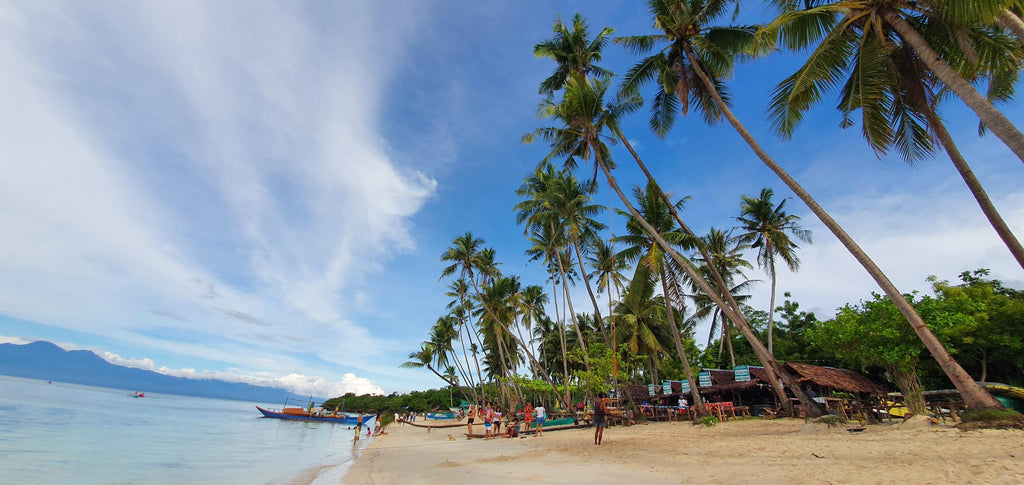
What to see and do on Siquijor. Including the best way to get there, how to get around the island, the best places to stay and play, as well as price guides.
- Location
- How to Get There
- Getting Around the Island
- Things to Do
- Where to Eat and Drink
- Accommodation
About Siquijor Island
On approaching Siquijor by water, the first thing that strikes you is the majesty of the round, tree covered mountains, pushing their way up through rock and wilderness into the clear sky. The scene is reminiscent of the geographical area – Bohol is not far and is famous for its round “chocolate” hills. These lesser known, but no less lovely green hills contrast beautifully with the blue sea. While the port is a relatively new addition that sees close to 170,000 visitors come and go yearly, the ancient, round mountains have been a constant, witnessing the changes to a mysterious island of witch-craft that once glowed red.
Christened the Island of Fire (Isla del Fuego) by the Spanish due to the abundant number of fireflies that inhabited the molave trees, the mystical island of Siquijor has a history that reaches deeper than its modern “founding” in 1783. According to local legend, Siquijor rose from the deep sea after a terrific storm had caused an earthquake that jolted the land and sea – a folktale that must have been born from an actual seismic event that occurred millennia ago.
Some Siquijor natives are well known for their spiritual practices including the making of healing medicine from natural herbs. Evidence of the existence of witches can be found in every souvenir store in the form of tiny voodoo-like dolls.
Today, along with native trees, majestic waterfalls and beaches, Siquijor has grand 17th century cathedrals and churches, beautiful Filipino-style houses, a sari-sari store every few metres, a very decent collection of quirky seaside bars, chill restaurants and possibly more dogs than humans – what’s not to like?
Although you may only be going for a short while, the island has everything you could need, adding that extra bit of reassurance. With a population of just over 160,000, there’s hardly any traffic all over Siquijor - unlike Manila, there’s no random tricycles pulling out in front of you at the last minute or heavily laden jeepneys to get stuck behind. The cities here feel more like villages. Even the water is calm, generally flat, shallow and very clear.
Everyone speaks either Visayan, Tagalog or English, so both domestic and foreign tourists needn’t worry about communication.
Location and How to Get There
Location
Located in Central Visayas, Siquijor is the southern-most island in the Visayan island group. Its location, however, is anything but remote.
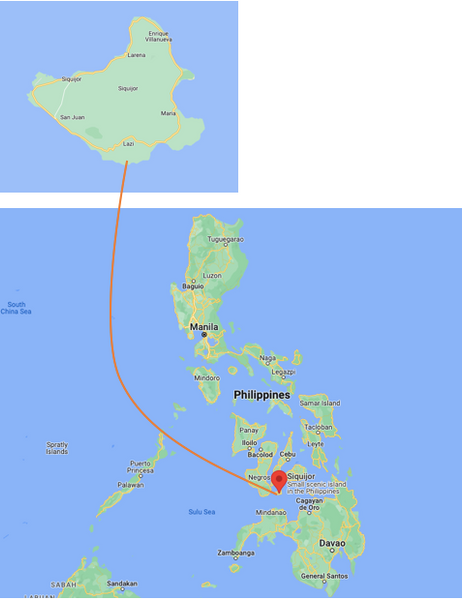
Just 30kms south from Negros Island, 36kms south west of Oslob, not that much further from Cebu, and just north of Mindanao, Siquijor has the benefit of being in the thick of the geographical action while offering a feeling of remoteness.
Getting There from Manila
Getting there is very straight forward. From Manila, take a plane to Dumaguete, then a ferry to Siquijor. A tricycle from the airport costs P250 ($5) (don’t let them charge you P500 if you’re puti) while a taxi will cost around P500 ($10). The ferry ticket from Dumaguete to Siquijor will set you back P250 plus a P15 (27 Cents) terminal fee.
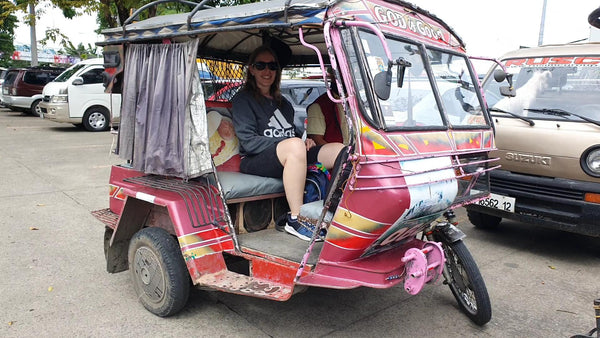
The tricycle ride from Dumaguete Airport. Photo by: China D
Note: There are several ferry companies that take passengers to and from the island daily (with the exception of Christmas Day and New Year’s Day). You can purchase tickets from the well signposted vendors located outside the port – your taxi or tricycle driver can take you straight to them.
Among the companies there are local favourites and if you can get tickets, great. But if they sell out (which happens quickly) don’t worry about using the others. We tried to get tickets for the popular Ocean Jet both to and from Siquijor but they were sold out each time. We ended up using Atlantis and the journey was fine.
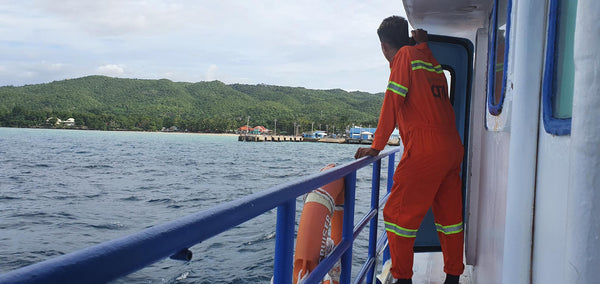
Approaching Siquijor Island. Photo by: China D
Good to know: There are plenty of small cafes and carinderias outside the port and a good selection inside the port, so there’s no stress when it comes to packing food. In fact, inside the port there’s even a Sans Rival bakery, so you can stock up on the famous local delicacy, Sylvanas, by the box if you wish.
Price guide in brief:
- Airport tricycle: P250 ($5)
- Airport taxi: P500 ($10)
- Ferry ticket to Siquijor, one way: P250
- Terminal fee: P15 (27cents)
Getting Around
- Scooter Hire
One of the best and cheapest ways to get around the island is by scooter. You can easily hire one from a number of rental places located right near the port – all you need is a driver’s licence and your passport. It'll cost around P300 ($5.50) - P350 ($6) per day. Sulit.
If you’re a little nervous about riding, don’t be. Siquijor and the little traffic it has is very chill. You’ll soon gain your confidence on the scooter should you choose to give it a go.
- Tricycle
If riding definitely isn’t for you, Siquijor has its version of the national public transport – the tricycle. You can use them just to get from point A to B for a trivial amount or, it is possible to hire one out for the day, complete with driver. This option will set you back around P800 ($14).
- Jeepney/Easyride
The other form of public transport, Jeepneys can take you from A to B on a fixed route and price. You have slightly less control because of this and because the time isn’t determined by any specific timetable or by you – the jeepney will leave once it is full.
- Van
Vans complete with a driver can be hired for tours around the island for about P2,500 – P3,000 ($45 - $55).
Things to Do
-
Balete Enchanted Tree/Fish foot spa
Balete trees are prevalent throughout the Philippines. Indeed, the largest in all Asia resides in the Aurora province, the oldest in Negros Oriental and even the ghost of one lingers on down Balete Drive in Quezon City.
They’ve been the centre of folk tales first told long before Spanish ships spotted the eerie glow of their resident fire flies from afar and possibly since before the centre of the religion the Spanish brought with them wandered through Jerusalem.
Superstition still surrounds these trees, especially in provincial areas. In this earthly realm, the balete tree grows by finding a host tree which it will eventually suffocate and kill. Perhaps this is why locals believe that spirits live within the giant roots, some diwatas (fairies) and some kapres (tree demons) from the mythical realm.

The enchanted balete tree and natural spring. Photo by: China D
What makes the 400-year-old giant balete tree in Siquijor unique is the natural spring that runs beneath it. The spring is captured in a man-made pool that has been filled with flesh-eating fish. For just P20 (35 Cents) you can have these fish nibble on your travel worn feet and bring them up good as new. It’s a really weird sensation to have another living thing take bits of dead skin off your trotters with its own mouth but the result is better than any emery board I’ve ever come across. Plus, you have the shade of the old balete tree and its majesty to admire with your spa treatment.

Nature's spa treatment. Photo by: China D
Location: Siquijor Circumferential Road, Lazi. About 20 mins drive from San Juan.
Entry Fee: 20 pesos (35 cents).
-
Cambugahay Falls
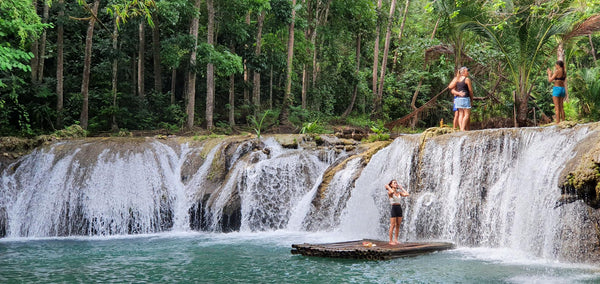
Top most and most tame tier of the falls. Photo by: China D
A beautiful example of Siquijor’s natural beauty, Cambugahay Falls has three rocky tiers which overflowing water from natural pools must negotiate before eventually finding its way and integrating itself to the Bay of Lazi 3 km away.
Cambugahay Falls gives tourists the option of paddling in the shallow, clear waters of its higher pools while enjoying the sight and sound of its short but beautiful waterfalls or jumping into the deeper waters of its lower tiered pools.
After you’ve recovered from the 135 steep steps down to the falls and rejuvenated yourself in the waters, you can once again increase your heartrate by swinging from a rope into the deeper part of the pools.
The great thing about Cambugahay Falls is there are 2 ropes to swing from. One is very tame and great for those that see themselves as adventurous rope swingers but are inexperienced or actually not that adventurous. The other, located at the lower pool, is a lot higher and the swing can be adapted to suit very adventurous/crazy types thanks to two platforms, one higher than the other. The swing a person can get jumping from the upper platform is surprisingly high. Even spectators will lose their breath. The lower tier pool is around 2-3 metres deep so the thrill-seeking tourists amongst us are safe to fall in from a great height.
Location: 4JQG+XM3, Siquijor Circumferential Road, Lazi (about 40 minutes from Paliton Beach). There is space on the road for parking a scooter or car.
Entrance Fee: 20 pesos each. There are cottages available to place your things while swimming, the cost is a donation.
There are a few vendors at the entrance of the stairs selling water and snacks. Even if you resist it before you visit the falls, a bottle of water is much appreciated after you make it back up those stairs.
-
Salagdoong Beach (Diving)
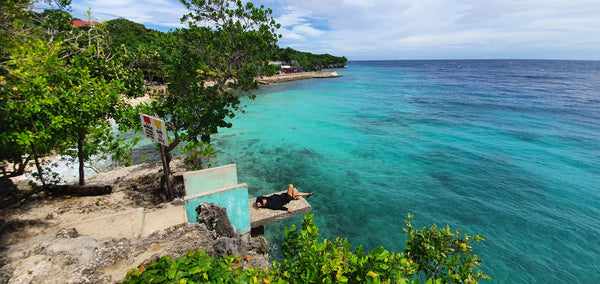
The most photogenic diving platform of Salagdoong Beach. Photo by: China D
A great spot for snorkelling, swimming and jumping off high things, Salagdoong Beach has waters so clear you can see right to the bottom even from the top of its 10-metre platform. For those just wanting to enjoy the beautiful surroundings, the crushed ancient coral of the beach is bleached white and offers a nice space to sunbathe as well as a gorgeous contrast to the calm, deep blue water. Due to this area of the Philippines being created from ancient coral, there is no sand - so you won’t be making any castles.
There are toilet facilities, a restaurant and a few concrete benches making Salagdoong an ideal place to spend a good portion of your day.

The road leading to Salagdoong Beach. Photo by: China D
Location: 2km off the Siquijor Circumferential road, you’ll follow a winding sealed road through green forest before reaching the sea.
Entrance Fee: Free. You just need to register at the booth located at the end of the road before heading to the beach.
Note: While you can still enter Salagdoong Beach, swimming is not permitted due to continuing beach maintenance operations (current as of 2023).
-
Paliton Beach (Sunset)
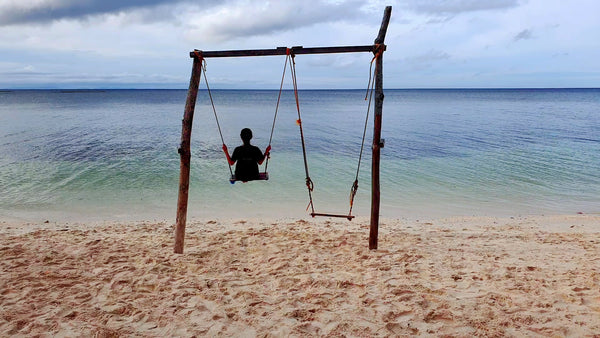
Paliton is a small but very popular beach with both locals and tourists. It’s famous for being the spot to watch the sunset. With so many beautiful places to watch the sunset or be around any time of day in Siquijor, this distinction bestowed upon Paliton Beach is a big one. Locals have helped Paliton become a convenient favourite by setting up small open air shacks that serve as sari saris and bars. So, while watching the sky change colour you can enjoy a Red Horse and a packet of Piattos.
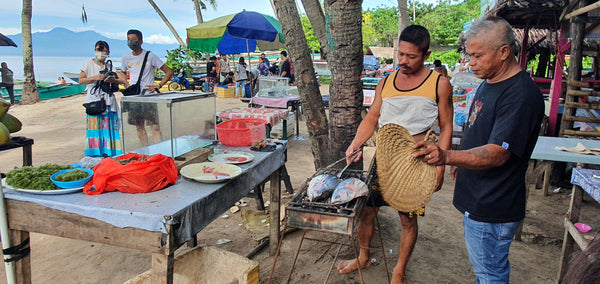
Locals BBQ-ing isda. Photo by: China D
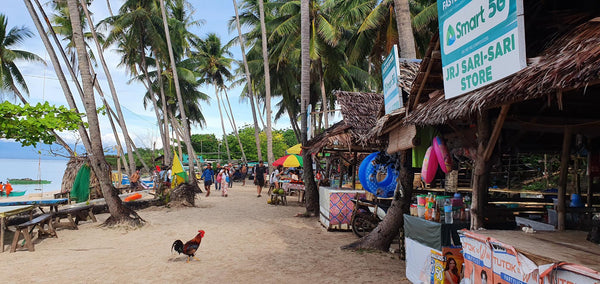
Why? To get a packet of Muncher. Photo by: China D
With fine white sand and clear shallow waters, it’s definitely worth visiting - even at sunrise. In fact, early morning before the crowds arrive is a great time to get there, hire a paddle board for P300 (for 2 hours) and spot the small schools of fish in amongst the coral while navigating the calm water. The view a few metres off the shore gives a different perspective from the one seen on the beach. Looking back at the rocky shore from the water, you can also see the beautiful purple mountains that jut straight from the sea on one side and the tiny ripples of the seemingly completely flat water coloured multiple shades of blue. Stunning.
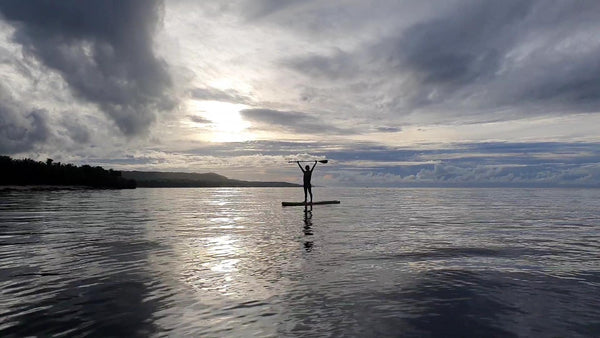
Early morning paddle-board.
Location: Off the Siquijor Circumferential Road on the West side of Siquijor, about a 15 minute drive from San Juan.
Entrance Fee: Free.
-
San Juan – Natural Spring, Bars and Restaurants
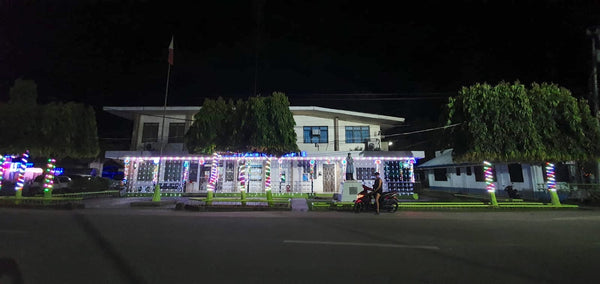
San Juan City Town Hall
San Juan is the laid-back, chill beach version of a city. While it gives you a city feel with petrol stations, pharmacies, grocery stores, bars, accommodation, motorcycle repair shops and salons just metres away from you, crossing the road to get to them is never a problem with basically no traffic to contend with.
Smack bang in the middle of San Juan is a natural spring which has been made into a public pool. Capilay Spring Water Park is a little oasis in amongst the concrete and steel of the modern city like village. The natural spring pool is long and uniform, resembling an Olympic sized swimming pool. As a reminder of both an ancient human ritual and modern plight for a significant percentage of the Earth’s population, part of the natural spring pool is reserved for laundry (used by some locals to clean their clothes) while the other part is for recreational swimming. It’s surrounded by park area with green grass, trees and, for your modern convenience, kiosks.
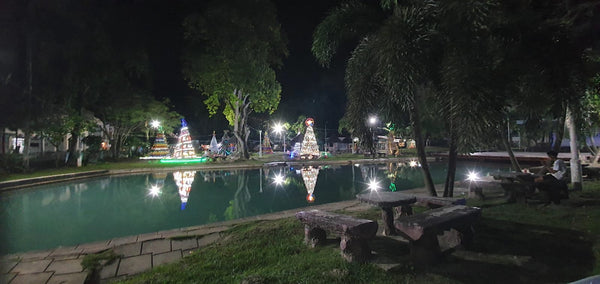
Capilay Spring Water Park at night
San Juan is surprising in terms of all it has to offer – it’s little wonder that it is the (un)official capital of tourists. There are an array of funky restaurants to choose from, each having a tremendous view and access of the water due to the fact they are basically on the beach. You can’t go too far wrong in choosing any one of them, however, we’ve reviewed the best in more detail here.
While Paliton Beach is certainly a great little spot for watching the sunset, any of the bars and restaurants that line the shore in San Juan were also awesome places to see the sun setting, plus they had the added benefit of seating and menus.
Hot Tip: A pharmacy in San Juan was the only spot we could find sunscreen for my ridiculously puti skin. All the sari sari stores we went to across the island just didn’t stock it.
-
Spanish era Churches and Convents
As with basically every corner of the Philippines, the Spanish influence from their 300-year residency is still visible. When it comes to Philippine architecture, the most prevalent structures left by the Spanish are churches.
Siquijor has many dotted around the island. Whether a follower of the Catholic faith or not, they can’t help but stir the senses – they are visually stunning. Their weather worn look and the ancient trees surrounding many of these Siquijor churches really make for a beautiful scene – a contrast between Mother Nature and man.
Although the passage of time has left its mark on these churches, they still stand despite their coral construction (the only material available at the time). As you would expect from structures built in the 18th and 19th century, some modern repairs have been made. What’s surprising is that a lot of these modern repairs often came as a result of damage from WWII, not so much Father Time.
Just driving around the island you will come across many churches and bell towers. In fact, as soon as you arrive at Siquijor port, you’ll see St Francis of Asisi Church, founded in 1783. It and its lovely big bell look like they were founded in 1783, which is exactly what you want – a living snapshot into the past, to an era that you missed out on seeing due to your later birth.
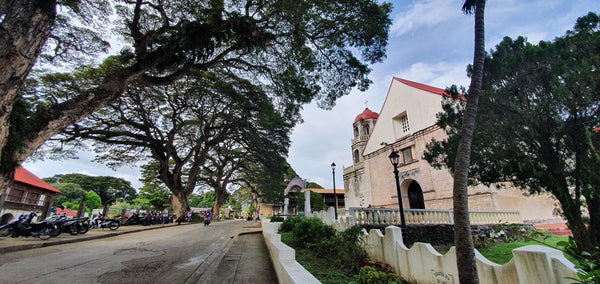
Lazi Church (right). Photo by: China D
Another church worth seeking out is St Isidro the Labrador Church (also known as Lazi Church). Across the narrow road from Lazi Church is the convent, named a Natural Cultural Treasure and nominated to be added to the UNESCO World Heritage list. You feel as though you’re in Noli Me Tangere to look upon it.
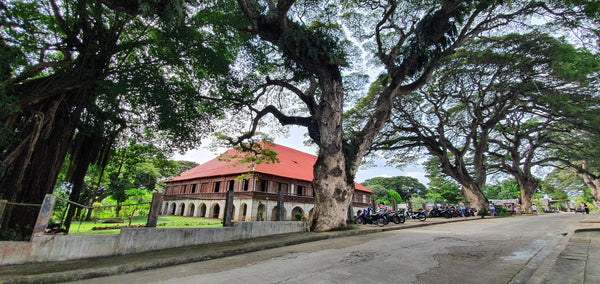
Lazi Convent. Photo by: China D
Aside from the church itself, what makes this one particularly nice is its surroundings. The road leading to the church is lined by trees and old low coral walls which seem to blend into the natural surroundings due to the blue/green lichen that has covered them. Opposite Lazi Church, on the corner of the road is a big beautiful tree, its massive roots displayed like church pews. There can’t be too many places in the world that have such striking contrasting features.
Location: 4JHM+4H6, Lazi
Entrance Fee: Free
-
Drive around the island
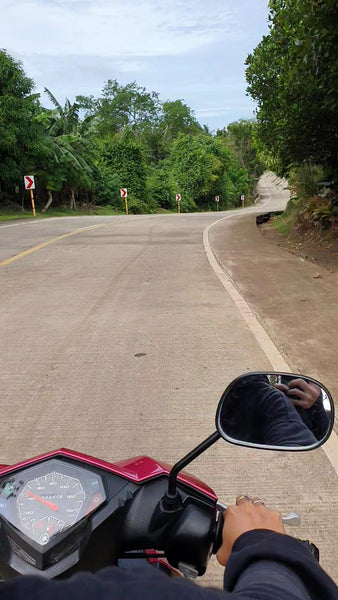
Just hire a scooter for 300 pesos and cruise around. Siquijor doesn’t have the influx of tourists that popular islands such as Siagao has. Consequently, the roads are uncongested and completely unintimidating to navigate. Plus, you can’t even get that lost – there’s just one main road that circles the island from which all other roads lead off, the Siquijor Circumferential Road.
You’ll see lots of dogs – some owned and others living by their wits. You’ll see a lot of schools and basketball courts. You’ll see the beautiful blue water surrounding the island. And the other unique thing you’ll notice in Siquijor are the local houses – although simple, they are still made in the Filipino style. They’re definitely not the hastily built besser block and concrete constructions that have popped up around Manila suburbs in recent years. These are still beautiful.
Where to Eat and Drink
Quite a few bars and restaurants have opened up on the island in recent years – your options are actually many and varied. It was interesting to see that, on an island with just 160 odd thousand residents, there should be such a variety of local and international cuisine – probably more so than any small provincial island in the country. It can be assumed that this is due to at least some of the newer residents being foreigners, settling on the island with their Filipino families and opening a small restaurant business. Either way, this small island has a substantial amount of high quality food options on offer.
Here are a few that stood out for us in terms of quality (of food and ambience), location and price:
-
Rogelio’s (near Fun-ta-Sea)

Located in San Juan city, we just walked into this place because we liked the look of their little bar, the floor made of sand, the resident dogs digging a little hole for lying in under the tables and the deck chairs laid right by the beach. It turned out to be a good decision.
Sitting in the deckchairs, we watched the sun set framed by the silhouette of long, leaning palm trees while nibbling on vegetable tempura - it was every bit as good as watching the sunset on Paliton Beach. There’s even a rope swing hanging from a palm tree that will take you right over the water. Lots of fun after a few San Migs.

Their menu is simple and reasonably priced. Fun-ta-Sea also have rooms to rent, the doors of which open right on the sea.
Location: 5F6Q+QFP, Siquijor Circumferential Road, San Juan
Price: $$
-
Dagsa
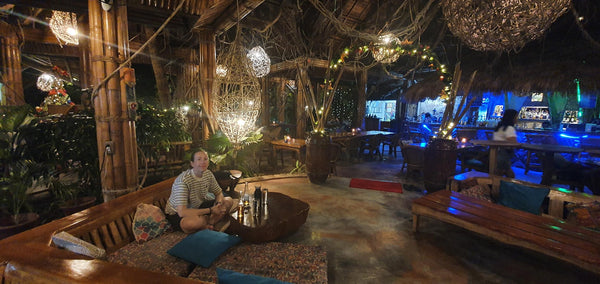
Once one of the only restaurants of its kind on Siquijor, Dagsa is well established and known amongst locals and tourists. It’s an old favourite and it’s not difficult to see why. Walking in through the entrance is like stepping inside an ancient balete tree – the roof in particular has been expertly crafted from natural branches that seem as though they are growing and twisting in and amongst each other.
There are two sections for guests to sit depending on their mood. One has Western style tables and chairs and the other is a fairly large wooden floor space with cushions and low wooden tables. At the end of the bar sits a small stage where live bands regularly play. Not only can guests see the stage from anywhere they choose to sit, they can (and probably will) interact with the friendly bands as they perform and banter with the crowd.
Their menu is more-high end, the food lovely. As you’d expect from such a menu, the prices are a little steep. This unfortunately includes the drinks for some unknown reason. Even a local beer is double the price elsewhere. Worth it at least once for the experience.
Location: 5FFG+7G7, San Juan. 10 minutes from Paliton Beach.
Price: $$$$
-
Marco Polo
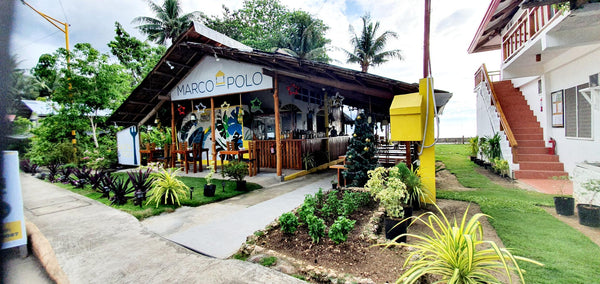
An Italian restaurant right on the water in San Juan city. To say that this place is authentic is an understatement. From the healthy green basil growing out the front to the Italian owner living next door, Marco Polo is a little slice of Italy right in Siquijor.
Aside from the exquisite food that will have you involuntarily grunting in approval, the stand out quality of this place is the all Filipino, female kitchen staff. Although this is an Italian restaurant (and you may be asking why you’d want to eat Italian food in the Philippines) the staff have developed an expertise, guided by the Italian owner, that is to be applauded – not least because they are every bit as good as any Italian. Every pizza dough, every focaccia has been made from scratch and is a good as any I ever tried in Italy.

Marco Polo is a celebration of Filipino and Italian, East and West, coming together to create something deliciously magical. The view doesn’t hurt either.
Location: San Juan, 6227 Siquijor
Price: $$
-
Aroi Makmak Thai Restaurant

Another example of foreign cuisine (that isn’t Western) on the island. Aroi Makmak is a Thai restaurant, authentic to the bone.
The decision to try this place was a bit of a sentimental one for us, we dined here exactly one year after our Thailand honeymoon (read our Thai food blog here). We can say that it was just like we were back there.
To test their quality, as much as go on a trip down food memory lane, we ordered straight forward classics including Pad Thai, Green Curry and cucumber salad as well as vegetable fritters. And, because we were on holiday, a Muay Thai cocktail. None of it disappointed.
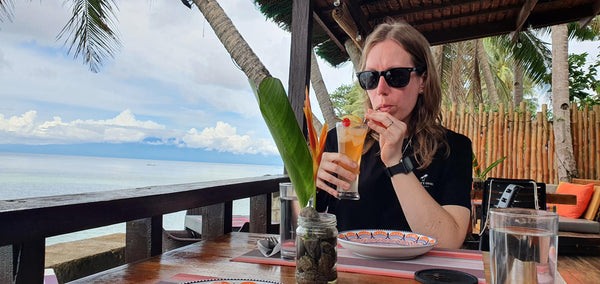
Kick to the head: sipping on Aroi Makmak's Muay Thai. Photo by: China D
Even the Muay Thai was beautifully garnished, plus it pleasingly packed the kind of punch its name suggested it’d have. Once again, being right on the water, the view alone would have made up for any lack in interior design or poor quality food, but it didn’t need to. Top Marks.
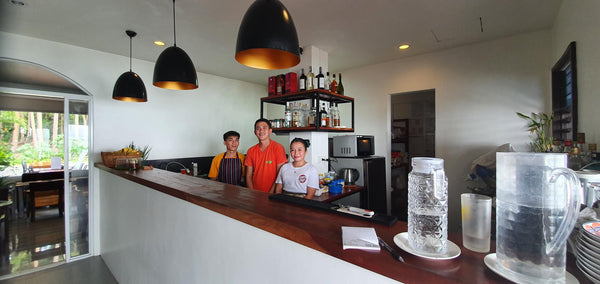
Location: San Juan, 6227 Siquijor
Price: $$
-
Balete Tree Restaurant
Located right next to the balete tree and natural spring, this restaurant is accessible by a wooden staircase that leads you to an upper deck complete with a Dagsa like ceiling. The natural wooden décor makes it feel a bit like you’re in a treehouse. There’s also a great view of the famous balete tree. The menu is more Filipino style, with items like fried rice, vegetable curry and pakbet. Portions were very decent and so too was the price.
Location: Siquijor Circumferential Road, Lazi. About 20 mins drive from San Juan.
Price: $
-
Dagsa-an Restaurant
Not to be confused with Dagsa, Dagsa-an Restaurant is a family friendly, classic Filipino restaurant offering high quality meals at great prices. It’s right on the sea, so diners have the option of sitting right beside the water or inside at their simple plastic cloth covered tables.
The menu is extensive. You can please just about anyone, from lola and lolo to the puti in-laws. The portions are for sharing and the price is good. Look for the blue fluorescent lights out the front.
Location: 5F7P+MG, San Juan
Price: $$
Accommodation
Accommodation in general on Siquijor is fairly inexpensive. You can get a decent double room from around US$30 per night. However, depending on the reason for your stay or what you need for comfort, there are many other options around offering more in terms of facilities.
After exploring the island, we came to the conclusion that if it’s beachfront, very inexpensive accommodation that you’re after, you can’t go too far wrong with any place in San Juan City. Perhaps the rooms are very basic, but the location (which is the thing that matters) is priceless.
Since you really can’t go too far wrong in choice of accommodation on Siquijor, we’ll just review the place that we stayed:
-
Monkey Business
A good experience overall. The rooms are clean and nicely decorated. I didn’t realise that I needed one, but the hammock on the decking became a favourite spot to chill after island adventures.

Their restaurant is open and spacious and like the rooms, simply but nicely decorated. There’s plenty of seating including some fun swings. They also have cards and other games for kids or tipsy adults, plus a small stage for live bands.
Their menu covers mainly Western favourites like burgers, pizza and fry-up fair for breakfast. One unique item worth trying are their banana fries! Although the food is pretty good, it is a bit on the pricey side. One fruit platter for example is 420 pesos – you could buy the entire stock of the fruit vendor selling next door for that price.
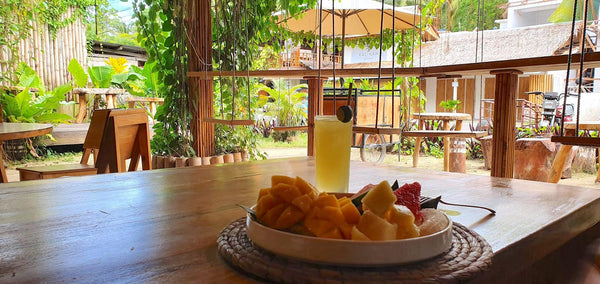
Location: Siquijor Circumferential Road (opposite Dagsa)
Price: US$110 for 3 nights
Here's a map of the places covered in this blog. Enjoy Siquijor!
Project Goalers! Liked the blog? Feel free to leave a comment below 👇
